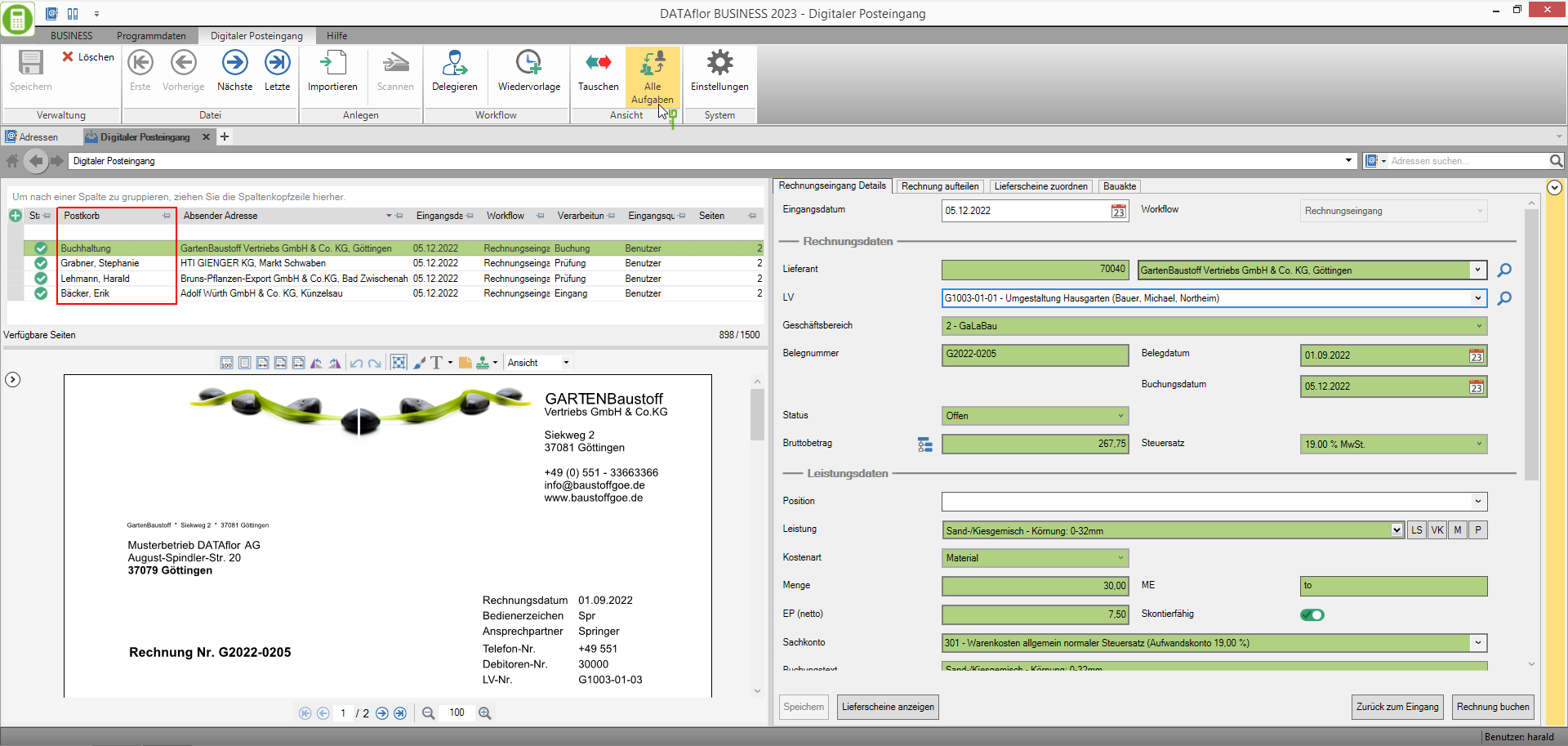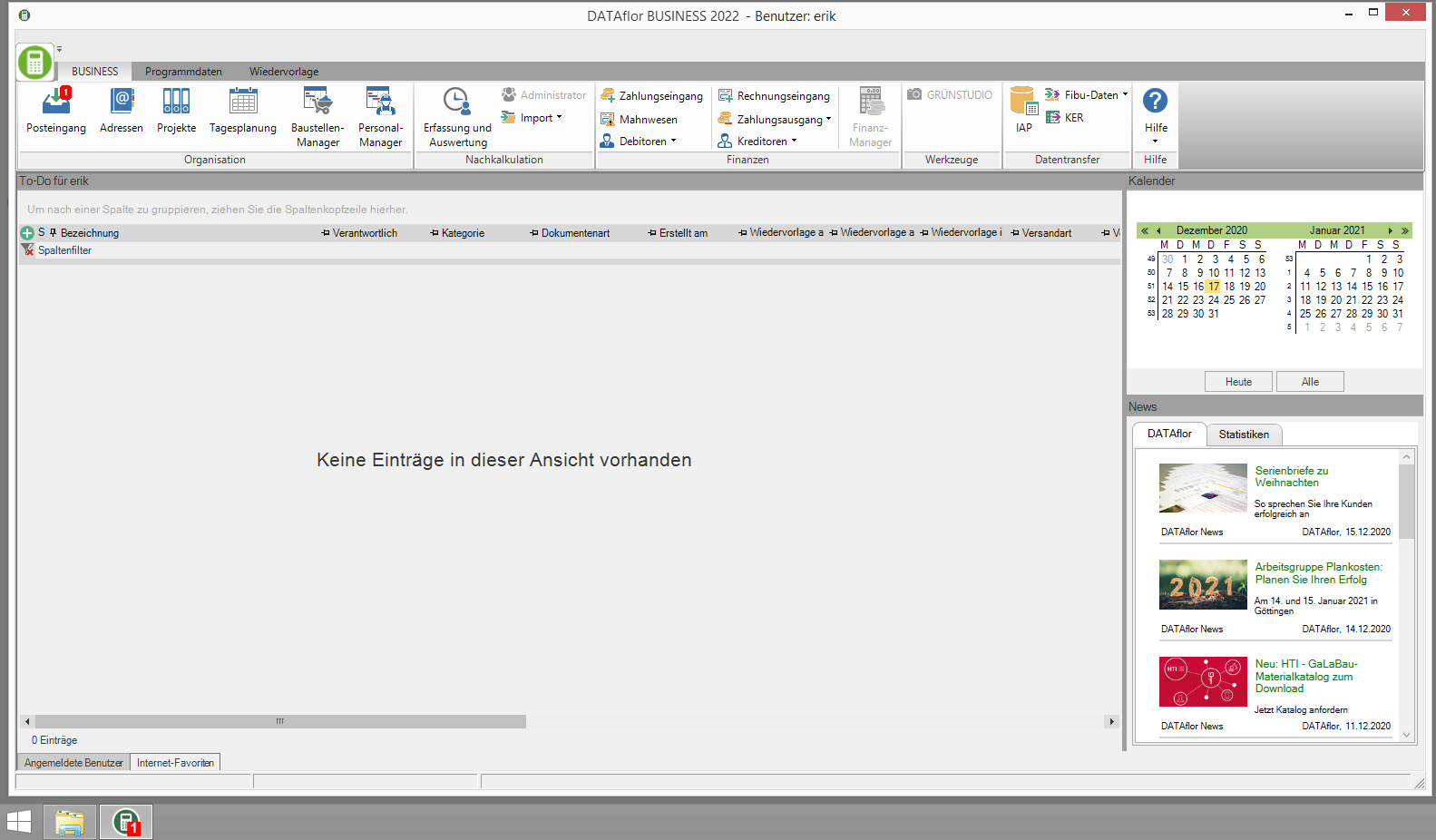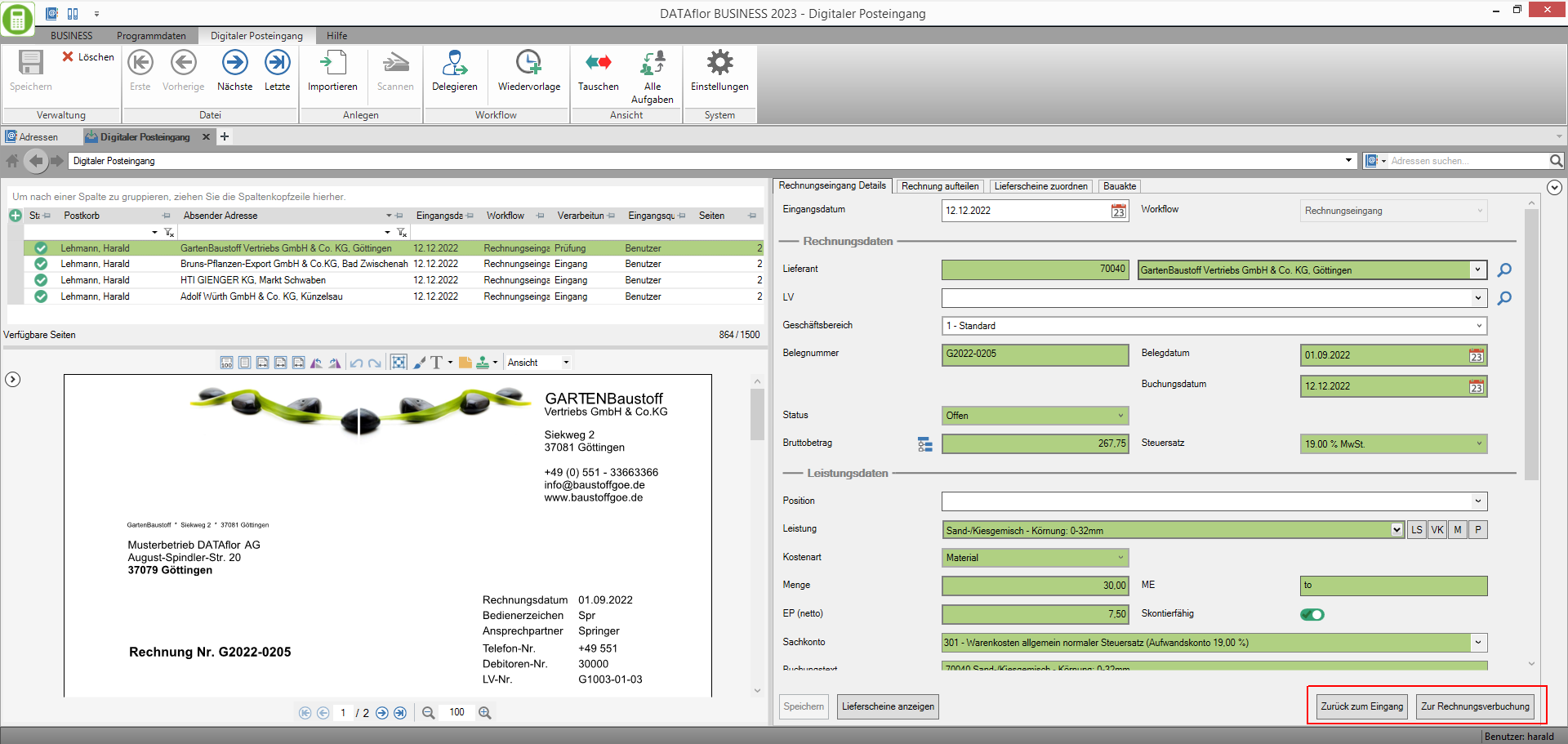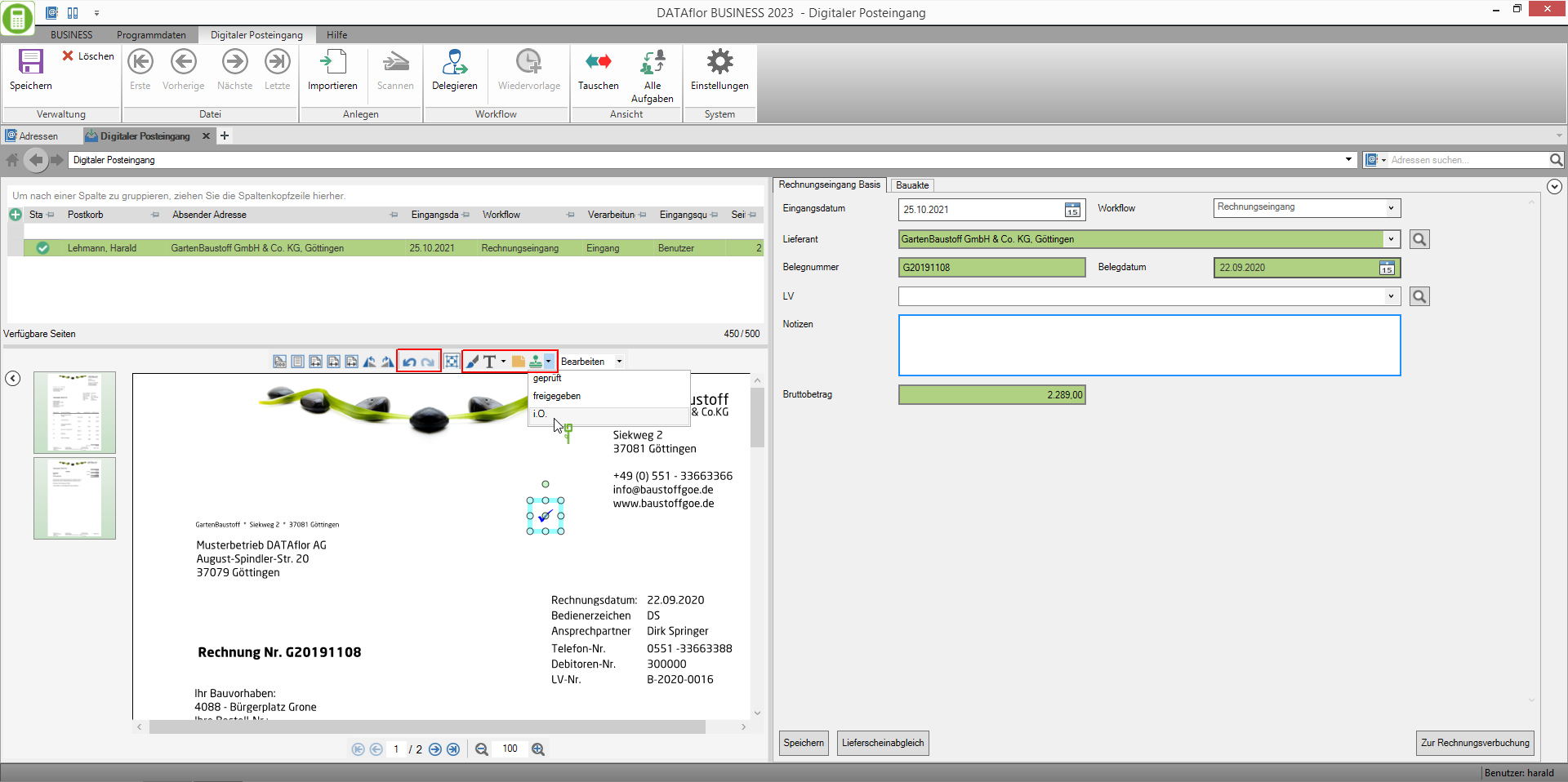Table of Contents
Edit task
Description
A task is automatically created for each file imported into the digital inbox. In the task view, the tasks assigned to the logged in user are displayed in a table.
The table shows the following information for each task to help you process the task:
- Column Mailbox: Shows which user or user group the respective task is assigned to
- Column Workflow: indicates which workflow the task is assigned to
- Column Processing step: indicates the processing step of the workflow in which the task is in order to identify what should be done for the task
- Column Input source: shows how the file was imported into the digital inbox
- imported by the user himself via file import, drag & drop or scanning → it's the word User appropriate
- File was imported via directory monitoring → the source name of the directory from which the file was imported is displayed (you define the source name of the monitored directories in the settings)
- Task shown in bold: marks a task as "unread"
change task
If there is more than one task in the task overview, you can switch between tasks using the following methods:
- In the task overview, open the task that you want to edit with a click of the mouse.
- The functions are in the menu First, Previous, Next and Last available to switch between tasks.
- You can also use the arrow keys on your keyboard to switch to the previous or next task.
show own / all tasks
By default, the tasks assigned to the current user are displayed in the task overview. The tasks can be assigned to a user in different ways:
- A file is created via the Directory monitoring imported. The task created for this is assigned to the user or users of the user group who are in the Workflow definition in the processing step Input is fixed.
- The tasks for the files that the user himself has to do with the File import, to Drag and drop or by digitizing a paper document via the Scan interface in the digital inbox.
- The user is in the Workflow definition assigned to a processing step or belongs to a user group assigned to a processing step. The user is shown the tasks that were forwarded to this processing step.
- A task can be delegated to another user for processing and is displayed to him in the task view.
About the function All tasks can users with the user right Show all tasks In the task overview, you can choose to see all the tasks of all users or just your own tasks.
- In the column Mailbox shows which user or user group the respective task is assigned to.
- You can edit, forward and delegate each of the tasks displayed on behalf of other users.
new assigned tasks
Create new address
When importing files for addresses that have not yet been recorded, the recognized data can be used to create the address.
collect data
In the fields of Data mapping / entry enter the data required for the task.
The fields displayed in the data mapping / entry depend on the workflow to which the task is assigned. in The Field Workflow you can assign the task to another workflow.
input forms
For the workflow invoice there are two different forms: Incoming Invoice Basis and Incoming Invoice Details. You specify which form is displayed to the user in the settings in the Workflow definition firmly.
With the formular Incoming invoice basis the user can assign the basic data such as supplier, document number, document date and LV to a task.
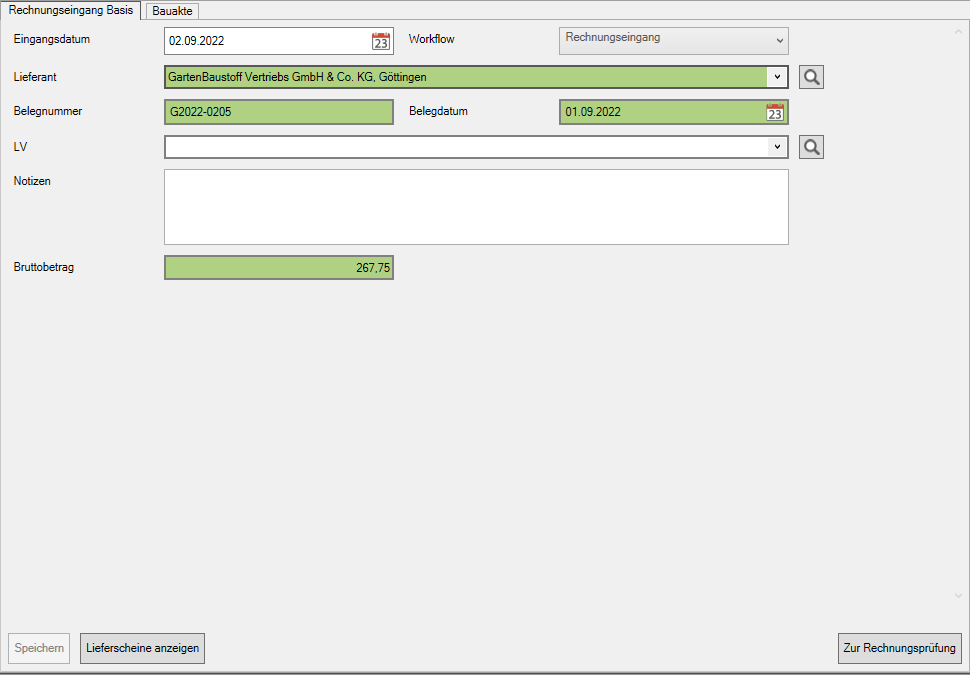
At the formular Incoming invoice details all fields required for the complete entry of incoming invoices are displayed. In addition, the tabs stand for data acquisition/allocation split bill and Assign delivery notes is available for storage, management and analysis.
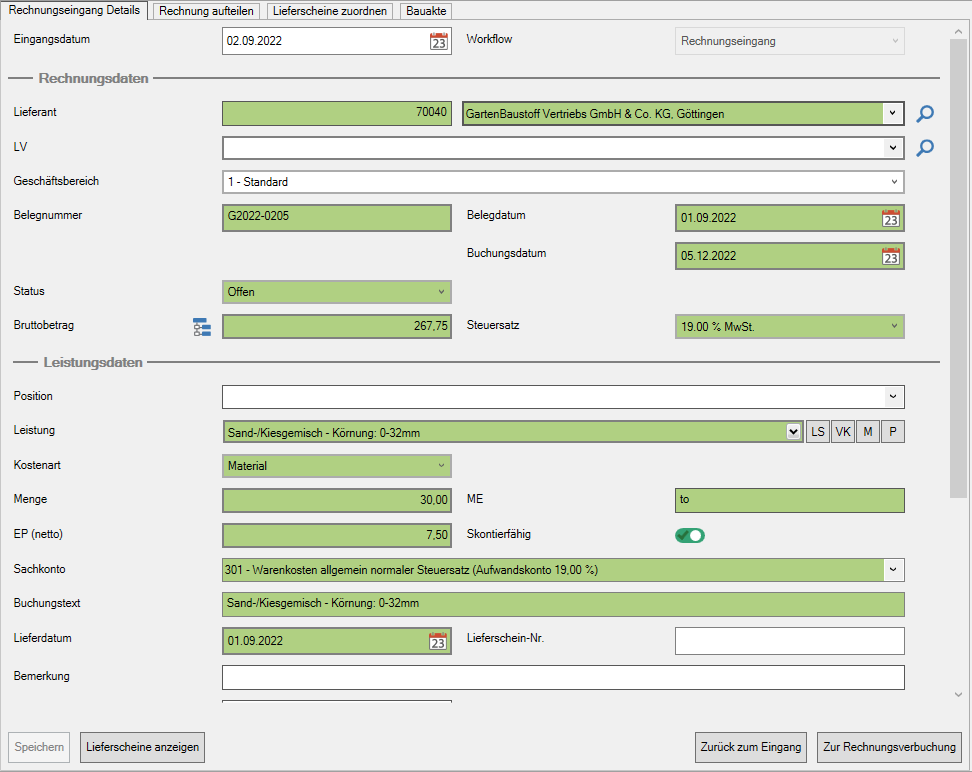
The tab Construction file is displayed for each task. The fields are preset with the data that you have entered in the settings for Pre-assignment building file have established. All data can be changed individually for each task.
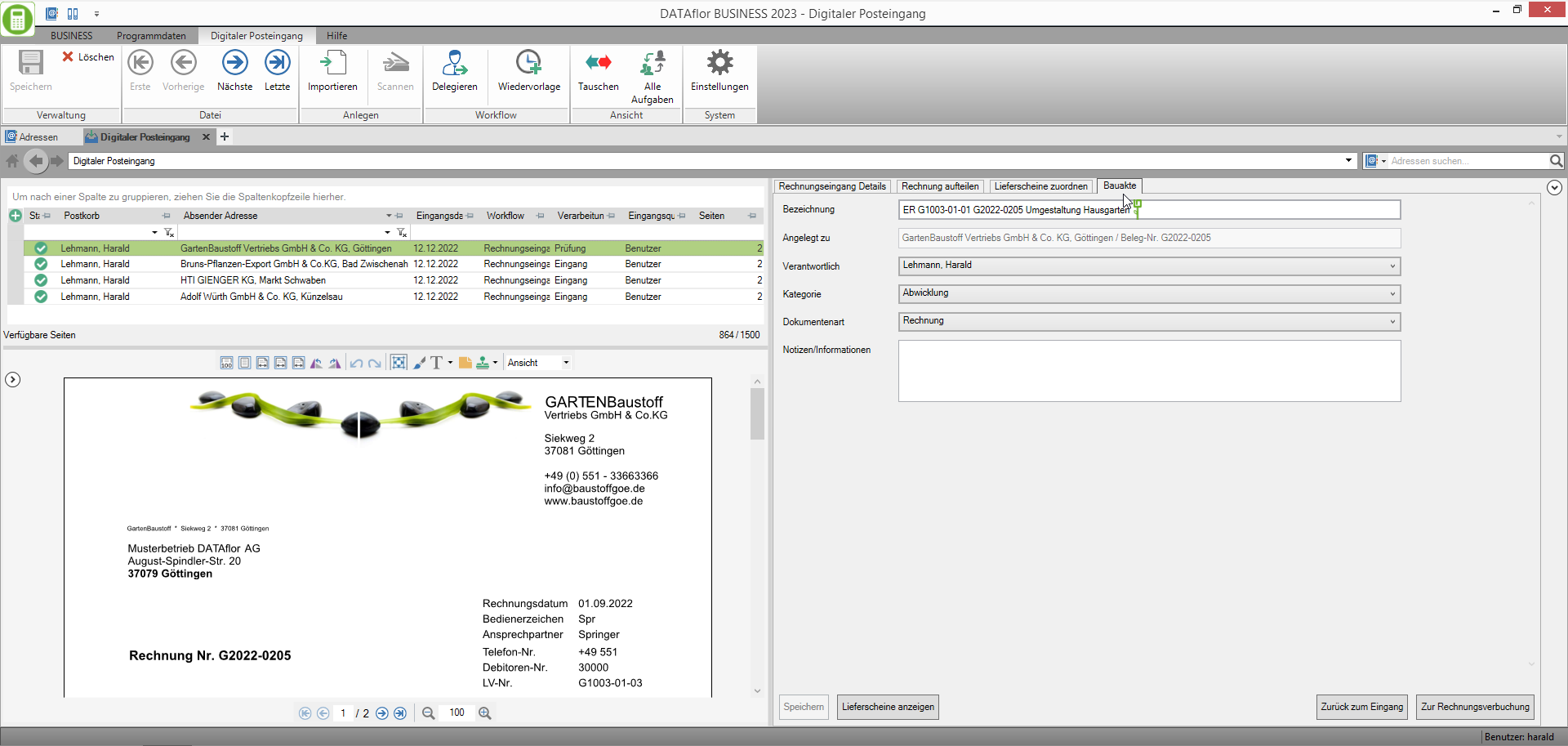
Assign and enter data
The following options are available for assigning and entering data:
- To take over data from the file view, first mark the field that you want to fill, then move the mouse over the value you want to take over in the file view (the value is displayed in the tool tip) and click on the value. In the fields Document number, notes and designation (of the document for the building file) can be done in this way while holding down CtrlKey to accept several values one after the other.
- Of course, you can also type the desired value into the field using your keyboard.
For example: LV number from the file view by clicking in the field LV take
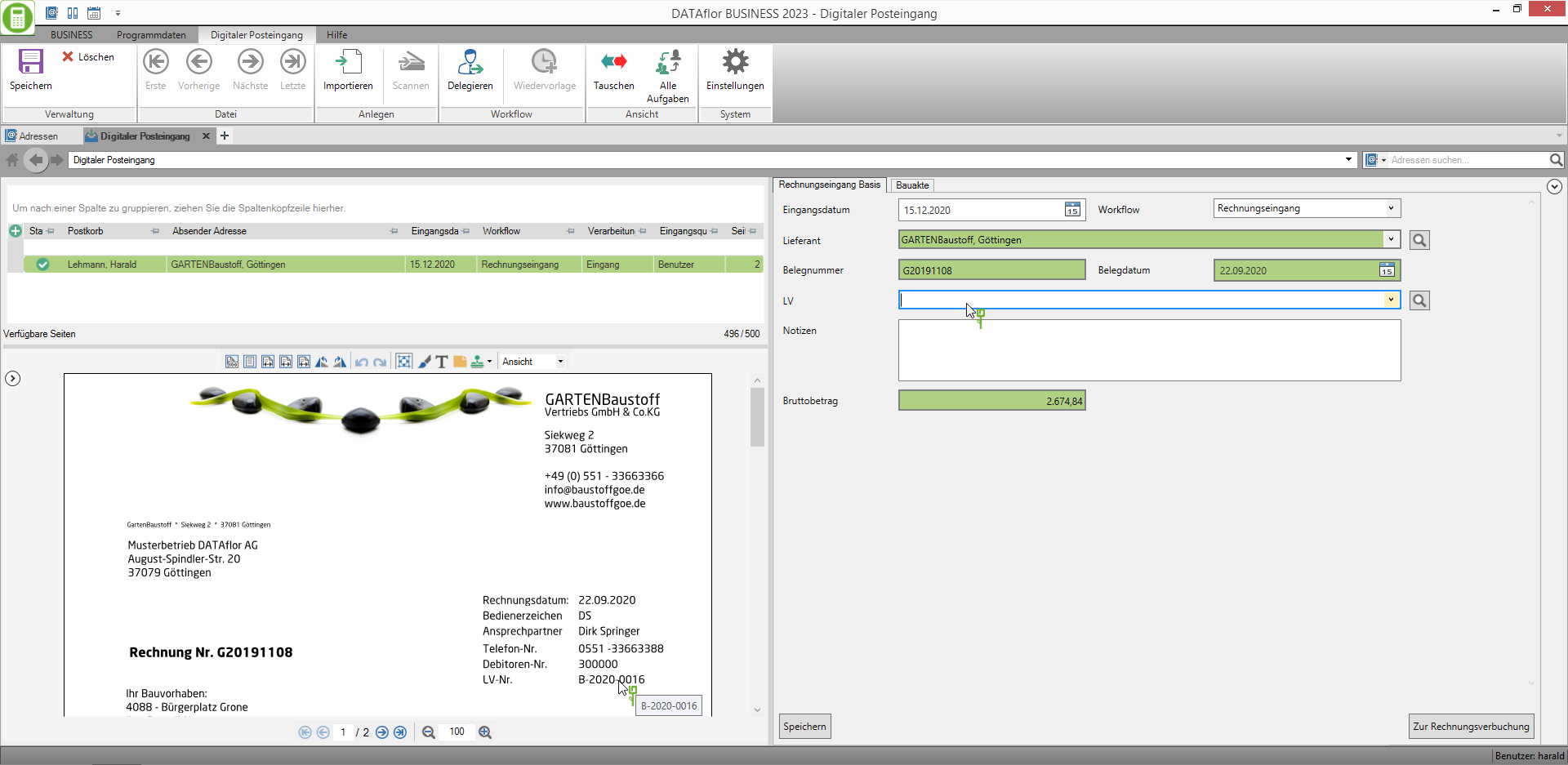
Colored field markers
The fields in the data assignment / entry can be marked with the following:
- Green background: The field was filled by the program's automatic field recognition.
- bold gray border: The field is mandatory and must be filled out by the user in order to be able to post the incoming invoice.
- highlighted in red: The entered value is not permitted. If you hover over the field with the mouse, the tool tip shows which error is present.
- bold blue border: This field is active. Data entries / selections are made in this field.
Automatic field recognition
The automatic field recognition of the digital inbox reads the data from the PDF file of the task and automatically enters the recognized data in the associated data fields. The automatically filled data fields are displayed with a green background. Data such as address, document number, document date, invoice amount, etc. can be recognized.
For example, how is the address automatically recognized?
The field recognition searches the PDF file to see if an IBAN is recognized. If no IBAN is recognized, a tax number is searched for, then for VAT ID and if none of this data is recognized, the customer number is searched for. As soon as a value has been recognized, the program checks in which of your recorded addresses this value is stored. If an address is found, it is automatically entered in the digital inbox.
uneditable fields
Is in the workflow invoice after the processing step Booking Another processing step is defined, for example, to inform an employee about incoming invoices that have been entered, the data can no longer be changed after the invoice has been posted, as it has already been used to save and post the invoice. Only in the field notes you can make changes and additions to the associated document in the construction file.
Delegate task
If you have been assigned a task (e.g. through the predefined workflow) that is to be processed by another user, you can delegate the task. To do this, select the function in the menu Delegate and select the user or user group to which you want to delegate the task. The selection list also shows which user is the site manager or who is responsible for the LV for the task in the field LV is chosen.

If a task is assigned to a user group, the task is displayed to all users of this user group. In order to clearly signal to the other users that you will be working on the task, you can take over the task by delegating the task to yourself. This means that the task is no longer displayed to the other users in the user group.
It is not possible to work on a task at the same time. If a user has opened the task for editing, it is automatically blocked for editing by all other users.
Forward the task to the next processing step
Are in the Data mapping / entry All mandatory fields (fields outlined in bold gray) are filled and there is no invalid value in any field (field highlighted in red), you can forward the task to the user (s) of the next processing step.
- To do this, use the switches below the data assignment / entry.
- The designation is based on the next processing step, e.g. [Assign for editing], [To post the invoice].
- About [Back to the entrance] you can assign the task at any time to the user or the users of the user group responsible for the processing step Reception of the workflow of the task is defined. The processing of the task starts from the beginning.
add comments to the file view
You can add various comments to the PDF file displayed in the view:
 - Add text field: the default settings are available, which are in the program parameter 180.10.30 Text comments are defined
- Add text field: the default settings are available, which are in the program parameter 180.10.30 Text comments are defined - Apply digital stamp: the digital stamps are available that are set in program parameter 180.10.20 Digital stamp are defined
- Apply digital stamp: the digital stamps are available that are set in program parameter 180.10.20 Digital stamp are defined
By clicking  select the desired stamp or the desired preset for the text field. Which stamp or which text preset was last used is saved so that you can click on
select the desired stamp or the desired preset for the text field. Which stamp or which text preset was last used is saved so that you can click on ![]() or
or ![]() be able to set the same stamp or several text fields with the same properties several times in succession.
be able to set the same stamp or several text fields with the same properties several times in succession.
Remove and edit comments
- If a task is forwarded to the next processing step with text marking, text field and / or digital stamp, these comments can be made by the next processor not removed or changed. They are permanently saved in the PDF file. In your DATAflor Construction file, the PDF file with the comments is saved as a version of the document.
- Affixed digital post-its can be removed and edited by the processor in the next processing step.
Feed
Messages for the next editor can be entered in the feed for each task. In addition, each time the processing step changes, it is automatically logged which user forwarded the task to the next processing step.
Open the feed by clicking ![]() on the right edge of the screen.
on the right edge of the screen.
The yellow mark indicates that there are manually captured messages in the feed.
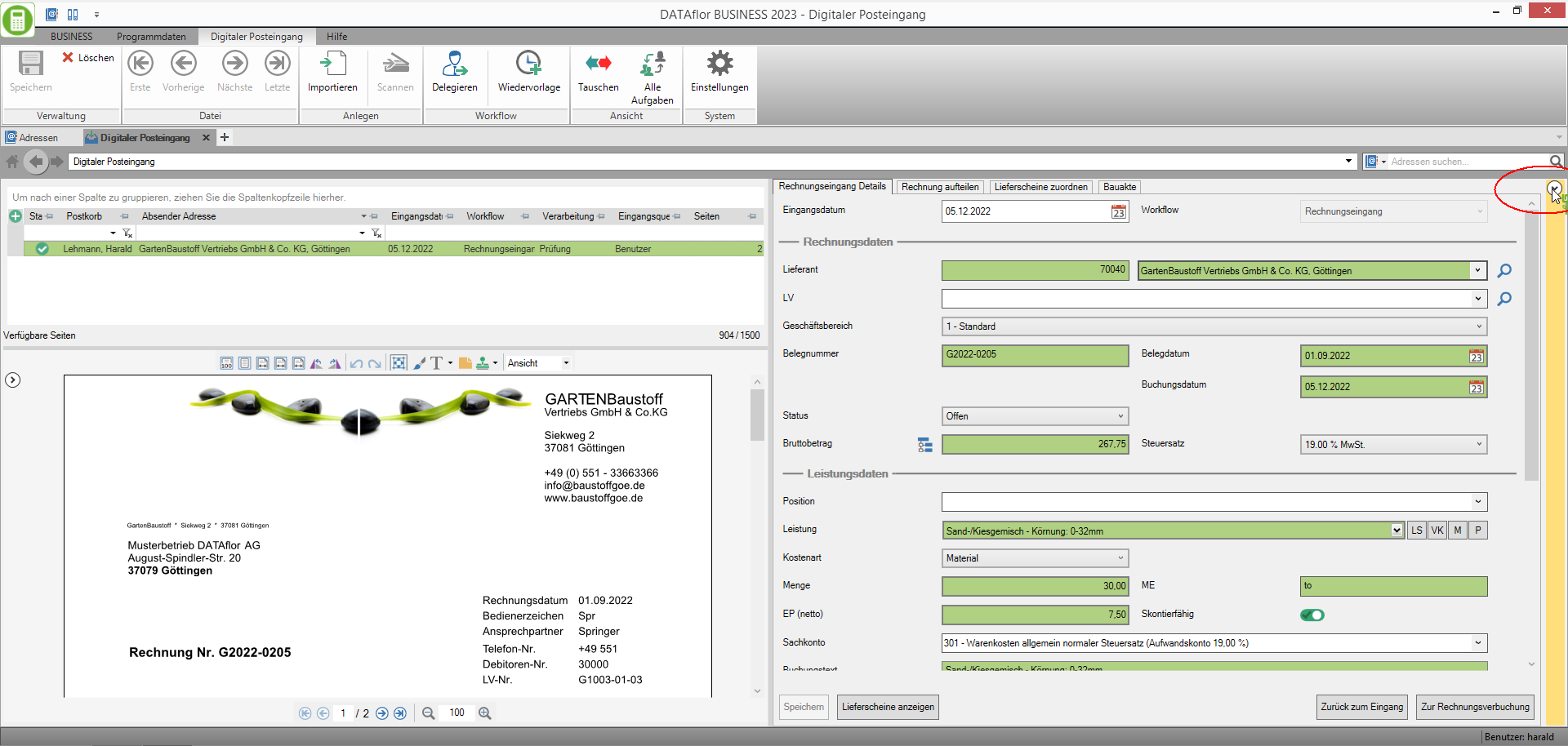
Enter your message in the field at the bottom of the feed and confirm with Enter or by clicking ![]() .
.
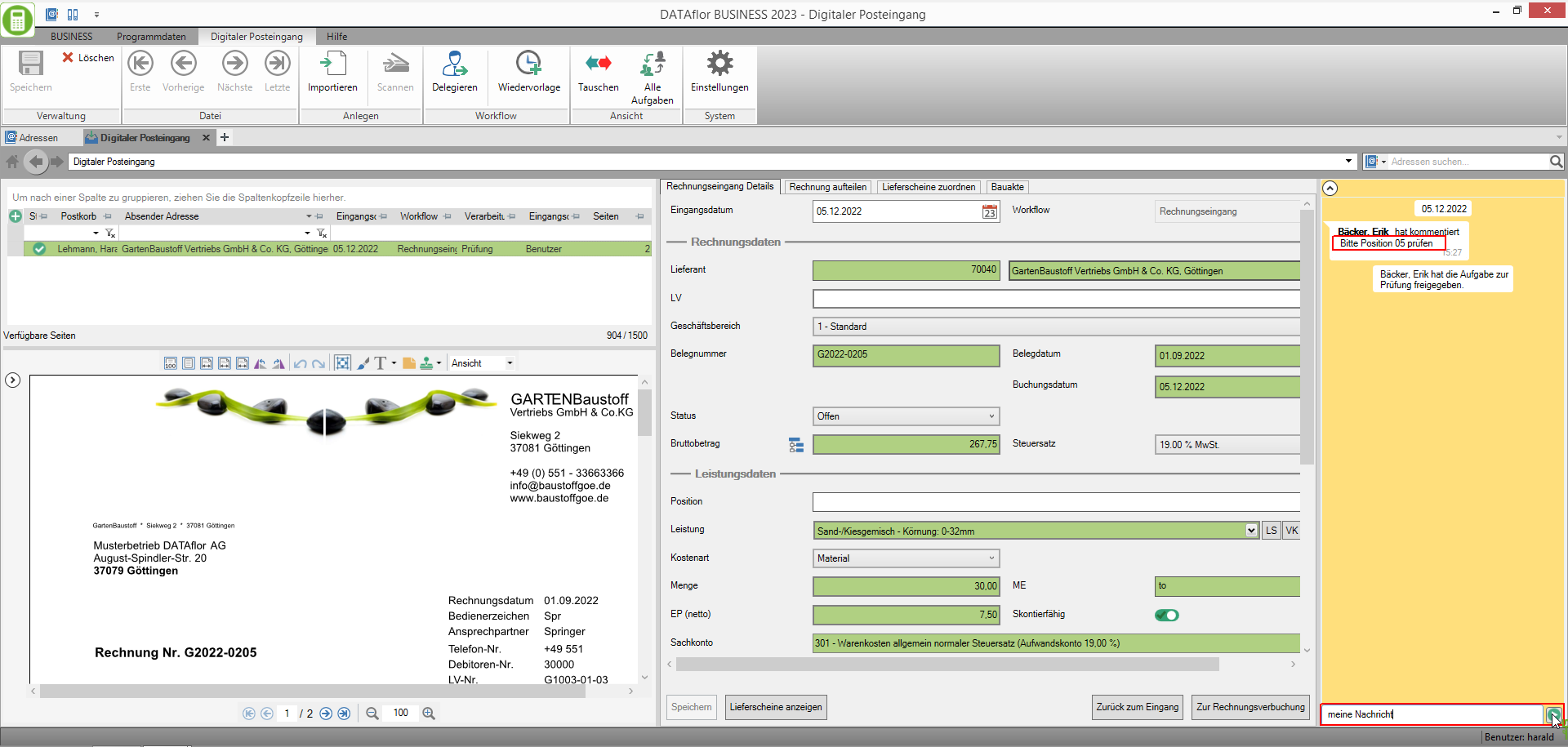
By clicking ![]() you can close the feed again.
you can close the feed again.
The feed history is in the DATAflor Construction file saved to the document belonging to the task and in the document information on the Feed tab displayed.

